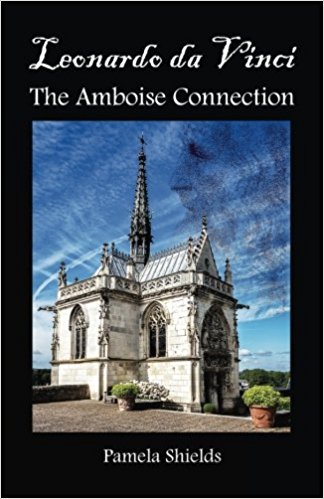Looming over the town of MonTrichard (the T is sounded) is the impressive donjon which has dominated the countryside for miles around for the last thousand years.
We assumed ‘donjon’ meant dungeon, a prison in the bowels of the earth but no, the French use dungeon too. Donjon means the exact opposite, architecturally speaking.
It’s what we call a Keep, a tower in a fortified residence, a last resort should the rest of the castle fall.
Mmm, say we, as we drive past, must stop one day and take a look. Richard. Sounds English. Wonder if there is any connection with Richard the Lionheart.
Although someone decided he merited a statue outside the Houses of Parliament in London, he had not one shred of loyalty to the land of his birth. He used England as a cash cow to fund his Crusades to the Holy Land and said he would sell London if he could.
Turns out it has.
Richard I inherited Montrichartd from his father Henry Plantagenet. The origins of the bridge over the Cher is thought to date from his time here. Montrichard came under English rule in 1044 when Henry Plantagenet ascended the throne of England as Henry II. In 1193 Richard’s brother, who ruled England as King John, signed Montrichard over to Philip Augustus, King of France.
Now for some dates.
In 1308, Cardinals acting for Pope Clement V, confined Jacques de Molay, Grand Master of the discredited Knights Templar, in the dungeon to await trial. In 1356, during the Hundred Years War, French troops were billeted here on their way to Poitou where they were defeated by Edward Plantagenet aka The Black Prince, in the Battle of Poitiers. 1418, the disinherited Dauphin Charles (thanks to Joan of Arc, the future Charles VII) is in Montrichard with his army before waging war against Burgundy 1422, Montrichard again receives the Dauphin Charles. He must have liked it here because as King of France he returned several times. He slept on the ground floor because he thought the upper floors might collapse. In 1436, during the rebellion of his son the Dauphin Louis (the future Louis XI) Charles VII, took Montrichard. In 1461 Louis XI and his Queen, Charlotte of Savoy, spent some time here following his coronation.
Although he owned Château Amboise, which was far grander, for some reason Louis XI chose the small chapel of Sainte Croix at the foot of Montrichard for the low key weddings of his daughters Anne and Jeanne de France.
The chapel became a parish church in the late 1500s.
First to be married was Anne in 1474. She was thirteen. She was married off to Pierre de Beaujeu, her senior by twenty years. It was a successful union.
In 1476, Jeanne, aka ‘the lame’, age twelve married next in line to the throne, her father’s second cousin, Louis, Duc d’Orléans. He was fourteen. The marriage was arranged when she was a baby and he was two. It was not a successful union.
On their wedding day, the boy groom said he would rather die than marry Joan. Forced to go through with the ceremony the King also forced him to sleep with her to provide France with an heir but he was so repulsed by his bride he said the marriage was never consummated. Joan said it was.
Anne, the King’s favourite child, went on to great things. Joan didn’t.
When King Louis died, Anne was appointed Regent of France during the minority of her brother Charles VIII.
When Joan was born with scoliosis, curvature of the spine and other disabilities, Louis removed her from public view, from her home in Château Amboise. He fostered her out to friends. With no children of their own, they doted on her and gave her a first class education. They hid her whenever her father paid one of his rare visits because they didn’t want her to hear the king say how ugly she was and how ashamed he was of her.
Joan found solace in religion. Her Confessor was Friar Jean de La Fontaine of the Franciscan community in Amboise.
When her father died and her brother became Charles VIII, her sister Anne allowed Joan to return to their mother in Château Amboise but alas her mother died four months later.
Joan stayed at Court. Her husband stayed away.
When Charles married Anne, Duchess of Brittany in 1491, the marriage contract stipulated that if he died first and had no male heir, the next in line must marry Anne to get one. Charles did die first. He had no male heir. The problem was that the next in line was Joan’s husband, Louis, Duc d’Orléans, crowned as Louis XII.
Louis asked the Pope for an annulment of his marriage so that he could marry Anne. Although Anne, like Joan, limped, Louis was in love with her. He told the Pope he had been forced to marry Joan against his will and the marriage was never consummated.
A broken hearted Joan said this was not true and fought for her rights as Queen of France.
A trial was convened before papal commissioners who annulled the marriage on the grounds of coercion. Louis made Joan Duchess of Berry and granted her a huge income for life. She moved to Bourges, founded The Order of the Virgin Mary, wore a nun’s habit and performed pious works. Louis did not attend her funeral.
François I, successor to Louis XII, often stayed at Montrichard with his court because the hunting was good.
In 1589 during the Wars of Religion, Henri IV ordered Montrichard be dismantled
In 1619 Marie de Medici, the Queen Mother, sought sanctuary at Montrichard. Her son Louis XIII, angry by her meddling in affairs of state, confined her to Château Blois. After two years she escaped and took shelter here, She became the figurehead of an aristocratic revolt with her other son, Gaston, Duke of Orléans, She lived in England when her daughter became Queen Henrietta Maria, wife of the tragic Charles I.
During the French Revolution, the town’s name was changed to Montégalité. The ancient church of Sainte Croix where Anne and Joan of France were married, was re-dedicated to the Cult of Reason. The confessionals were used as sentry boxes.
In 1917, during WWI, American troops were billeted in Montrichard.
In 1940, during WWII, the French government moved to nearby Chissay. The administrators lived in Montrichard. On June 14th, the Fairground and the Quai du Cher were bombed. Three hundred died.
In 1942, the Cher marked the line between occupied and unoccupied France. Montrichard was in the occupied zone.
In 2002, Montrichard experienced a moment of fame when it was mentioned in the film Catch Me If You Can as the place where Paulette Anton, mother of the infamous Frank Abagnale Junior, was said to be born.
Montrichard stands in for Montpellier where his father is thought to have met his French mother during World War II. She married the American soldier when she was sixteen. He was twenty-eight. After the war, Frank and Paulette moved to New York, where Frank opened a stationery business on Madison Avenue.
In the film the swindler Abagnale Jnr set up a facility in Montrichard for printing corporate cheques. He was tracked down and arrested by the FBI. Tom Hanks/Carl Hanratty found him forging Pan Am payroll cheques. The scene of the arrest was filmed, not in Montrichard, but in Quebec, Canada.
When you have climbed the donjon as far as is safe, you will be rewarded with a wonderful view of the town and the Cher valley. There is not much left to see of the Keep itself which looks far more imposing when viewed from the streets below.
Montrichard is worth a visit for the truly awful, hysterically funny manikins in the lovely little museum. There isn’t much that France gets wrong but considering it was la famille Tussaud, who practically invented wax models, it really is about time President Macron appointed a Minister for Historic Tableaux.
When we asked Madame in the ticket office how to pronounce Montrichard she said to sound the T – MonTrichard. This is very rare in France. Very rare. An anomaly.
We thoroughly enjoyed our day in MonTrichard but there, it is very rare for us not to do so in La Belle France, so rare that it is, like the pronunciation of the name, an anomaly.
Post by Pamela Shields
Pamela, a Graduate and Tutor in the History of Art, trained as a magazine journalist at the London College of Printing and has been a freelance writer for over twenty years. She has a passion for history and has published several books on various subjects.




Posted on Nov 10, 2018 by scribbling4bread
0